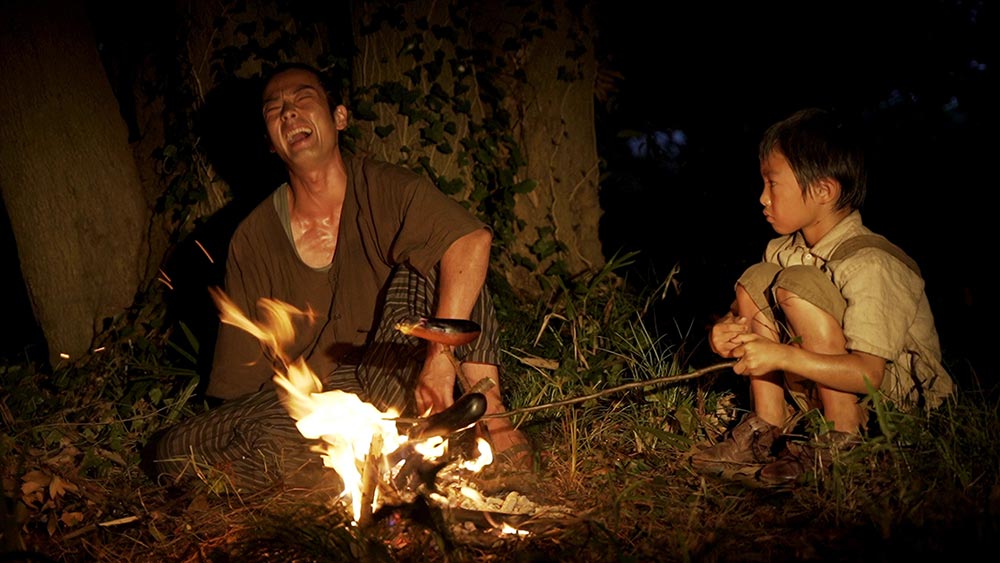After breaking onto the film scene with his singularly nightmarish Tetsuo: The Iron Man in 1989, Shinya Tsukamoto’s continued cinematic efforts have proven him a master filmmaker. But his mastery of the medium doesn’t mean all the bells and whistles that usually accompany such stature here in the United States—million-dollar crane and drone shots, brain-breaking production values, small villages worth of CGI-rendering computer servers and so on—but rather the ability to do more with less, which is especially impressive given the fact that Tsukamoto reliably serves as his own editor, cinematographer, and screenwriter. His latest film, Shadow of Fire (2024), is a period piece of modest scale in the same vein as his prior Killing (2018), an unsentimental interrogation of the mythologized jidaigeki samurai epics which are among Japan’s most beloved cultural exports. Before Killing was Tsukamoto’s 2014 adaptation of Shohei Ooka’s confessional novel Fires on the Plain, about Japanese soldiers driven to cannibalism while serving in the Philippines during World War II. Shadow of Fire returns to WW2, this time to ordinary people’s struggles to survive in the immediate and impoverished aftermath of the war.
None of the characters in the film are given names, but Tsukamoto’s narrative focuses on an orphan played by Ouga Tsukao, who is reluctantly adopted by a young widow (Shuri) whose makeshift home is in a former tavern. The widow also develops an uneasy relationship to an abusive soldier who reminds her of her dead husband. These styles of attachment are, to say the least, fraught. In a recent interview with Sight and Sound, Tsukamoto observed that Fires on the Plain was told from the perspective of a ground-level soldier rather than “a great military commander” because “in the end, it’s the lowest-ranking people who kill or are killed. It is the little people who suffer the most.” Shadow of Fire’s first half is set entirely in this enclosed space, which fosters an atmosphere of claustrophobia and fear of punishment that is offset by infrequent reminders of the world outside—the effect is anonymized, shipwrecked, dreamlike. In one surreal flourish, Tsukamoto's camera slowly pulls out from a shot of a devastated room, which resembles nothing so much as a landscape in the vein of Edward Steichen's aerial photographs of bombed-out European cities during the war.
While Tsukamoto’s last three films rarely approach the visceral mania of his more famous genre work from the ‘90s, they form a sobering trilogy meditating on the liability of violence to erupt between people. If Tsukamoto sees the world (and human interrelationships) as inherently volatile, his handheld digital cinematography and flat, unshowy lighting style give this violence a harrowing, tactile quality, that renders his films null and void as potential works of genre exploitation or all-you-can-shock transgression. (That was never the modus operandi of the Tetsuo films or 1995’s Tokyo Fist either, but Tsukamoto’s earlier work remains far more notorious than his more recent films.) In Shadow of Fire, the orphan’s journey toward survival necessitates tremendous sacrifice and pain, but it would be wrong to claim that Shadow of Fire valorizes suffering. Tsukamoto is compelled by existential questions that are made all the more urgent by the fact his characters have no option to suppress their memories or seek refuge in alternative circumstances. The resulting film is unsettling and visceral, and it will keep all but the most jaded viewer guessing until its final moments. Its disquieting attempt to reckon with a world engulfed in cruelty is, in its own twisted way, an act of hope.
Shadow of Fire screens this evening, July 17, at Japan Society as part of Japan Cuts. Director Shinya Tsukamoto and actor Mirai Moriyama will be in attendance for a Q&A.



